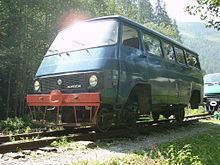 | ||
Valea vaserului moc ni winter
A Mocăniță ([mokəˈnitsə]) is a narrow-gauge railway in Romania, most notably in Maramureș, Transylvania, and Bukovina. Archetypely, they are situated in mountainous areas and the locomotives operating on them (which themselves can also be referred to as mocănițăs) are steam-powered. These railways were built for cargo and passenger services - some in the era of the Austro-Hungarian Empire, before 1920 - but fell into disrepair over the years. Some are now being rehabilitated for the purposes of tourism.
Contents
- Valea vaserului moc ni winter
- Moc ni linia industrial fieni pietro i a moroieni
- Etymology
- Vaser Valley Mocnia
- Other mocnias
- References
Moc ni linia industrial fieni pietro i a moroieni
Etymology
The word mocăniță is a term of endearment, derived from the Romanian word mocan, meaning shepherd or one who lives in the mountains, and suffixed as feminine and diminutive in keeping with the tradition of naming conveyances and indicating small size. It's also been suggested that it means "coffee machine", as one of the little locomotives is reminiscent of one of these in action.
Vaser Valley Mocăniţa
The most well-known mocăniță runs in the Vaser Valley in Maramureş County. This railway was constructed in the period 1933-1935 and uses a gauge of 760 mm (2 ft 5 15⁄16 in). It was partially destroyed by German troops during the war, but was rebuilt again. It has primarily been used for logging, and is still used for this purpose, but in 2004 work began on rehabilitating it as a tourist attraction. A Swiss enthusiast who came to Romania in 1987 helped this greatly by starting an organisation for saving the railway: "Hilfe für die Wassertalbahn in Rumänien".
Several steam engines are used: 764-211 (Măriuța) was built in Berlin by Orenstein & Koppel in 1910; 763-193 (Krauss) was also built in Germany, in 1921; and there are five Romanian locomotives built at Reşiţa between 1953-1955. Diesel engines (built in 1960s-1970s) and other vehicles such as converted minvans also run on the lines. The latter are used by border police, rangers and others for getting quickly up the mountains.
The tracks run from Vişeu de Sus, from a yard on Strada A. I. Cuza, 1.5 km north from the town centre. The main line is 43 km long, from Vișeu de Sus to Comanu, near the Ukrainian (former Polish) border, though the service may terminate before then at Faina. This trip usually takes between 3 and 4 hours each way.
There are two other branches: along the Novat Valley (13 km) and towards Stevioara (3 km). The train can occasionally come off the rails, but at a speed of 10 km/hour this poses no danger, and experienced passengers help to get the train back on the rails! The Vaser Valley is an exceptionally scenic location, the habitat of many bears and deer, along with many cattle and sheep. The line is run by a private company, Căile Ferate Forestiere (CFF). As well as regular services, trains can be charted by tourists; special services are also run, for instance on New Year's Eve. This video made about this Mocăniţă is accompanied by local music from Maramureș.
The railway, and the Mariuța engine complete with rolling stock featured in episode 3 "Wild East" ("From the Dniestr to the Danube" in the US version) of Michael Palin's New Europe. It can be viewed in part 3 of that episode on YouTube at time index 2 minutes 54 seconds.
